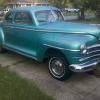-
Posts
988 -
Joined
-
Last visited
-
Days Won
7
Community Answers
-
soth122003's post in Continued driveline vibration was marked as the answer
Just tossing this out there, but how sure are you that it's the drive line? From what you said, you rebuilt the D/S and now you have a vibe at 40 mph. While I agree that it's the most likely culprit, a little bit of trouble shooting can save a lot of head ache later. When you get to 40 mph and the vibe is kicking hard, push the clutch in and let off the gas and see what happens. If it goes away, it's probably in the clutch or tranny. If it continues, check the D/S. Did you put all the washers back in place? Did use mix new hardware with old? You said you used a liberal coating of grease on the bearings and needles. Was it applied evenly to all areas? 1/8 oz of grease more at one point at high rpms can induce a fair vibe. I've trouble shot lots of problems where I was sure it was one thing and was something else entirely.
On the subject of why put the D/S in the same way it came out, Young Ed is onto the most probable reason. Time and wear, road debris and nicks, crud built up on the shaft all contribute to the way the D/S likes to set.
Joe Lee
-
soth122003's post in 1934 Plymouth PE was marked as the answer
Welcome to the forum. First things first. If the fuel pump/lines hasn't been updated to use ethanol fuel...don't use ethanol fuel. Update or stay with non-ethanol fuel. Mine wasn't when I got it and a month or so later it left me stranded.
Next is zinc additives. Not needed.
Oil. 10w30 or 40 will work fine if the engine is in good shape. You said it was about 95% restored so engine should be good. Trust but verify it was rebuilt.
Now for the jump. WITH DEAD BATTERY ONLY. The new modern lithium ion packs probably won't work as they need a minimum voltage to work (10.5v) and most all are geared to 12v systems. So 5.4v wont cut it. If you use the old jump packs with a 12v batt installed inside it, Hook the pos cable to ground and the neg to the starter if it has a switch on the pack. Then with key on turn the switch to run the starter. When started turn switch off and disconnect. If the jump pack does not have a switch hook the neg cable to the starter and touch the pos to ground. This way if the jumper arcs (and it will) you won't weld the cable to the threaded post of the starter and mess up the threads. Other option with no jump pack, push start the car in 2nd gear. I've done this many times and it usually starts with in 15 to 20 feet. On a hill, push in clutch and roll, doesn't matter if forward or backward put it in 2nd or reverse and pop the clutch and drive on home and charge the battery with a charger.
With a car that won't start it may be battery, generator, voltage regulator or what ever. Tow the car home. Fix the problem and verify the batteries condition. If the genny or the VR is out the car won't run past the batteries output. Once the batt is dead the car won't start until the other issues are addressed and fixed.
Hope this helps. Oh and please post PICs when you get the car.
Joe Lee
-
soth122003's post in Engine stand for Flathead 6 was marked as the answer
I looked at the 1k and 2k stands on HB. And while I agree with JB that the 1k should be enough for the engine, The way the base of the 1k and the 2k are designed would make me go with the 2k. The 1k base is square and more narrow at the front and the 2k base is y'd and seems like it would handle the weight distro better. This makes the 2k more stable when breaking torques and stuck bolts or rotating the engine etc. Last thing you need is a stand that will support the weight but tips over when breaking or applying torques or rotating the engine to work on it more easily.
Joe Lee
-
soth122003's post in 1949 P18 manifold color. was marked as the answer
Silver. At the top of the page click the tab for resources and then click the P-15 reference. Further down it will list the Body paint colors and the engine and accessory color for 1946-1949 Plymouths.
Joe Lee
-
soth122003's post in Leaking Freeze Plug was marked as the answer
Leaking freeze plug shouldn't hurt the starting of the car. Once your up and running, I would do a flush with vinegear and rinse with water. See other topics on flushing the cooling system (let the flush solution set in there a few days or miles before rinsing). The with that done address the leaks. Also when you replace the freeze plugs, clean and flush the gunk out before installing the new ones. 50 psi water hose and sprayer worked wonders for me by spraying in the freeze plug area.
Joe Lee
-
soth122003's post in tire width for DeSoto Suburban was marked as the answer
This might help. Also there is a thread currently on page 1 with the header "tires" that might be of interest.
https://tirepressure.com/tire-sizes
I checked the P195/75r15 @ 26 psi will support about 1279 lbs. each tire. 32 psi supports 1411 lbs. each
Joe Lee


